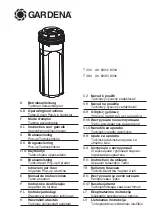
AXESS AUDIO VIDEO IP INTERCOM FROM 1 TO 4 PB
Technical data sheet no. 600-0206B
www.castel.fr
Page 9 / 12
FR
EN
Logical input functions (or flags)
The logical inputs enable two functionalities in particular:
•
Creation of a logical status from which actions can be conditioned in relationships.
•
Creation of a counter that will be updated according to events and depending on the value of this counter,
possibly trigger one or more actions.
The configuration of the logical inputs requires the use of the CastelServeur software.
Configuring relations
The Web server is where automatic controls, also called relations, are configured
There are two types of relations:
•
Scheduled: used to trigger actions at identified time slots. There are three levels of priority for a schedule
relation (high, medium and low).
•
Logical:
↘
Logical condition: used to trigger actions at certain status conditions (active, inactive, etc.). A logical
relation can integrate several conditions by operators such as AND, OR, NOT, XOR. Likewise, a logical
relation can trigger several actions.
↘
Digital condition (counting): used to perform actions by comparing the value of a counter with different
thresholds. It is also possible to add or subtract counter values and compare the result obtained.
Configuration of web server users (software users)
The Web server for the station can grant, modify or remove rights for users by specifying their login, password and
operating language.
Profile configuration
Station operating profiles can be created, modified or deleted. Each profile specifies a station priority, a configuration of
function buttons and access rights to the station.
The station can operate with a unique profile or with different profiles according to time slots.
RTSP (Real Time Streaming Protocol)
The station has an integrated RTSP server that allows an external RTSP client to retrieve the audio stream from the
station.
An authentication mechanism can be activated to secure access to the stream.
It is possible to define the desired parameters for the stream provided.
SNMP (Simple Network Management Protocol) function
The station has an SNMP agent agent to respond to SNMP requests and to send notifications (TRAPS) to an SNMP
manager.
From the web pages, it is possible to:
•
Configure different communities (read/write)
•
Configure system data (sysContact and sysLocation)
•
Configure notifications (recipient, community...)
•
Download the Castel MIB
It supports SNMPv1 and SNMPv2c.
ASCII notification function
The station incorporates a notification mechanism through ASCII strings.
From the web pages, it is possible to:
•
Configure settings to connect to a remote TCP server and specify the characteristics of the connection
•
Configure events to send an ASCII frame to this TCP server
Self-test function
The station has several tests to validate its operation:
•
HP/MIC self-test: Allows you to remotely test the correct operation of the HP and the microphone. From the
"advanced settings" page it is possible to adapt the levels of this test according to the installation
environment. This test can be triggered from the web server or by an SNMP command. The result of the test
is visible via the web server history and an SNMP notification.
•
Mechanical button self-test: the detection of a blocked mechanical button (contact present for more than
20s) is signaled by an SNMP notification and an event is reported in the web server history.
History function
The history allows you to view the events that have occurred on the station. They are listed with the date and time of
the event concerned, a description and additional information.
Backup and recovery of system parameters
•
A full backup or recovery of the station parameters can be made (configuration, profiles, relations,
directory…)






























